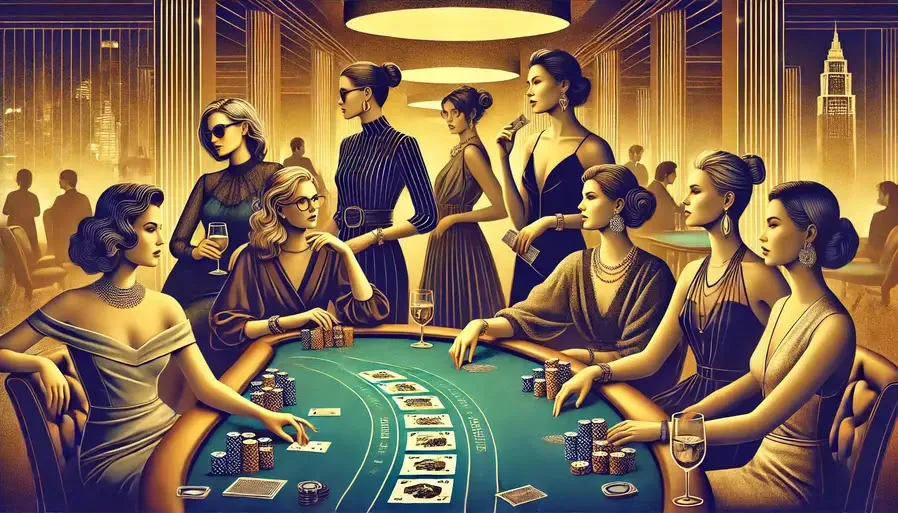For many years, poker was seen as a male-dominated game, with women struggling to make a name for themselves in the industry. However, times are changing, and female players are increasingly claiming their rightful place at the table. From early pioneers to modern champions, women have proved they have the skill, determination, and strategic mindset needed to succeed in poker. But the road has not been easy.
In this article, we will explore the journey of women in poker, from the first female players to today’s rising stars. We will also discuss the challenges they face, the impact they have on the industry, and whether women-only tournaments are necessary or discriminatory. As poker continues to evolve, platforms like Casino Grosvenor are witnessing a growing number of female participants, demonstrating that the game is no longer just for men.
The Road to Success: The First Women in Poker
The history of women in poker dates back to the early 20th century when few dared to challenge the norms of the time. Alice Ivers, known as “Poker Alice,” was one of the first female players to gain recognition. A skilled card player and gambler, she travelled across the United States, earning a reputation for her sharp strategy and fearless betting.
As poker evolved, so did the presence of women in the game. In 1977, Barbara Enright became the first woman to enter the World Series of Poker (WSOP) Main Event, breaking the barrier for future generations. She later became the first woman to win an open event at WSOP, proving that gender was no obstacle to success in poker.
Their contributions paved the way for more female players to enter professional poker. Over the decades, women have continued to challenge stereotypes, slowly but surely carving out a place for themselves in high-stakes tournaments and professional circuits.

Modern Women in Poker: Who Are They?
Today, women are more visible than ever in professional poker, competing at the highest levels. Players like Vanessa Selbst, the only woman to reach the number one ranking on the Global Poker Index, have demonstrated that female players can be just as dominant as their male counterparts. Selbst’s career earnings exceed $11 million, proving that poker success knows no gender.
Another influential figure is Liv Boeree, a professional player and science communicator who has won both European Poker Tour (EPT) and World Series of Poker (WSOP) titles. Boeree’s analytical skills and strategic mindset have made her a role model for aspiring female players.
Platforms like Grosvenor Casino Poker have also seen an increase in female participation, showing that women are no longer an anomaly in the poker world. Their presence is growing, and with it, the perception of women in the industry is changing.
Stereotypes and Barriers: What Do Women Face?
Despite their growing numbers, female poker players still face significant challenges. One of the biggest obstacles is the stereotype that poker is a “man’s game.” This perception can lead to women being underestimated at the table, sometimes making it harder for them to gain respect from their male opponents.
Another issue is the underrepresentation of women in major poker events. While participation has increased, the percentage of female players in high-stakes tournaments remains low. Many attribute this to the lack of visible role models, as well as societal expectations that discourage women from engaging in competitive gambling.
Harassment and intimidation are also concerns. Some female players report facing inappropriate comments or being treated differently at live events. This has led to calls for safer and more inclusive environments where women can compete without feeling uncomfortable or unwelcome.
Beyond social barriers, there is also the challenge of sponsorship and recognition. While male players often secure lucrative deals and media attention, women sometimes struggle to gain the same level of support. However, as more women prove their skills at the table, sponsorship opportunities are beginning to improve.
How Women Are Changing the Poker Industry
The rise of female players is bringing positive changes to the poker industry. More women at the table mean a broader audience for the game, leading to increased viewership and interest in poker events. This shift is encouraging casinos and online platforms to create more inclusive marketing strategies.
Female players are also inspiring a new generation of poker enthusiasts. As more women see successful professionals competing at the highest levels, they feel encouraged to enter the game themselves. This is helping to balance the gender gap and diversify the player base.
Additionally, the growing presence of women in poker is influencing the game itself. Studies suggest that women tend to play with a different approach, often being more calculated and patient compared to their male counterparts. This diversity of playstyles is enriching the poker landscape and making the game more dynamic.
Women’s Tournaments: Necessity or Discrimination?
One of the most debated topics in poker is whether women-only tournaments are necessary. Supporters argue that these events provide a welcoming space for female players, allowing them to gain confidence without the pressure of competing in a male-dominated field. These tournaments also help create networking opportunities and foster a sense of community among female players.
On the other hand, some critics believe that women-only tournaments reinforce the idea that female players need special treatment. They argue that true equality comes from competing on an equal playing field, without segregating players by gender. However, given the current challenges women face in poker, these tournaments may still serve a purpose in encouraging more women to participate.
Regardless of the debate, what remains clear is that women’s presence in poker is growing. With platforms like Casino Grosvenor offering more opportunities for female players, the future of women in poker looks promising. As barriers continue to break down, poker is becoming a more inclusive game where skill, not gender, determines success.
